Do you know how to format unallocated disk on Windows? If you are searching for a detailed guide to formatting the unallocated disk, you are in the right place. In this passage, we will talk about three ways to format the unallocated disk. Hope you can get the best answer from this article!
Why Format Unallocated Disk
Before we know why we format the unallocated disk, we need to figure out what an unallocated disk is.
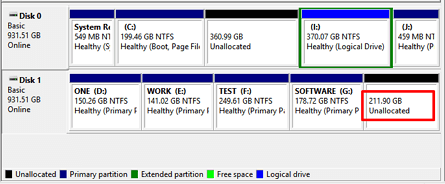
From the above definition, we know that an unallocated space is a space that is not yet used. It can be used to place files, but no application can write files and data to this program. Unallocated space is not available on the disk because there are no partitions on the disk. To improve disk performance and utilization, unallocated space must be formatted before the disk can be used.
You may also like to know the following:
How to Format Unallocated Disk [Three Ways]
There are three ways to format unallocated disks on Windows. You can use Windows built-in tools: Disk Management and Diskpart command, or choose a professional third-party tool: EaseUS Partition Master Free. Which one is best? You can follow the table to find the most suitable method for you.
| Comparison | |||
|---|---|---|---|
| Operation Difficulty | Easy to use | Medium difficulty | Hard to use |
| Suitable Users | For beginners | For experienced users | For professionals |
EaseUS Partition Master is the best way to format unallocated disks. And if you are not skilled in computers, EaseUS Partition Master is your best choice.
Let's look at how the three methods work on formatting the unallocated disk on Windows.
Method 1. Format Unallocated Disk Using EaseUS Partition Master
EaseUS Partition Master is the best free disk manager supporting Windows 11/10/8.1/8/7 and Windows XP/Vista. You can easily format the unallocated disk space to FAT32, NTFS, exFAT, and Ext2/3/4 to work with different operating systems. Download it, and you can learn how to format unallocated disks.
You can format the unallocated disk by creating a partition on the unallocated space and choosing the wanted file system format during the process. Let's look at how it works.
Step 1. Right-click the hard drive partition and choose the "Format" option.
Step 2. In the new window, you can set a new name for your selected hard drive partition. Then click the "OK" button.
Step 3. Click the "Execute 1 Task(s)" button, then click "Apply" to start formatting the hard drive partition.
Method 2. Format Unallocated Disk Using Disk Management
Disk Management is the Windows built-in tool that can easily initialize, format, or partition hard disks. You can format the unallocated disk by creating a new simple volume. Here are the steps:
Step 1. Select Disk Management on your computer and open it. Or press "Windows + R" and type "diskmgmt.msc".
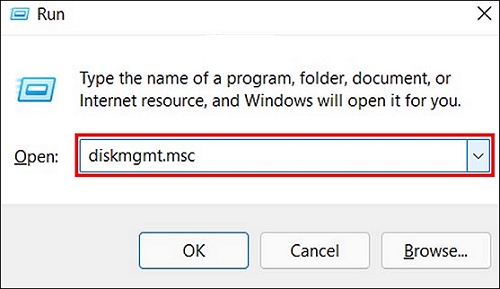
Step 2. Find the disk and right-click the unallocated space.
Step 3. Select "New Simple Volume" and click "Next."
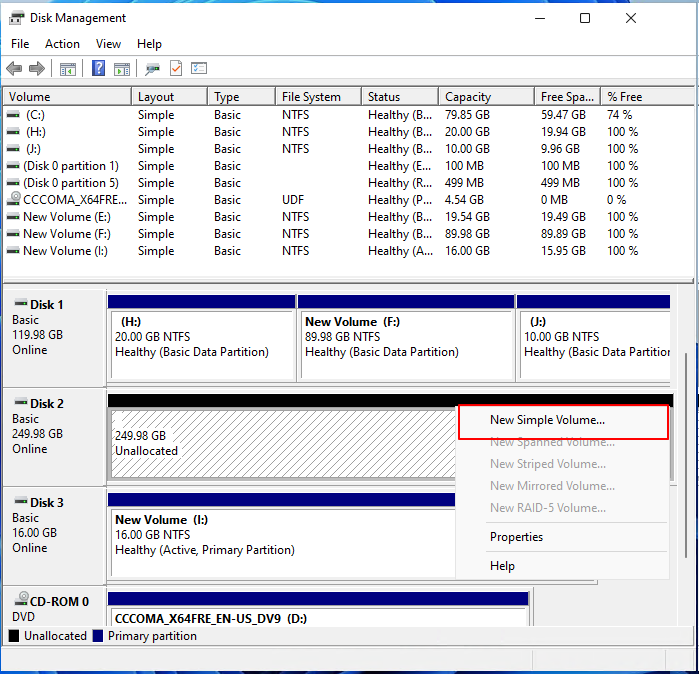
Step 4. Set the new volume's size, choose a letter to assign the drive, and click "Next."
Step 5. Choose "Format the Volume with the Following Settings" and set the right format and appropriate parameters.
Step 6. Click "Next" after choosing the correct parameters. And then click "Finish" to format the unallocated space on the disk.
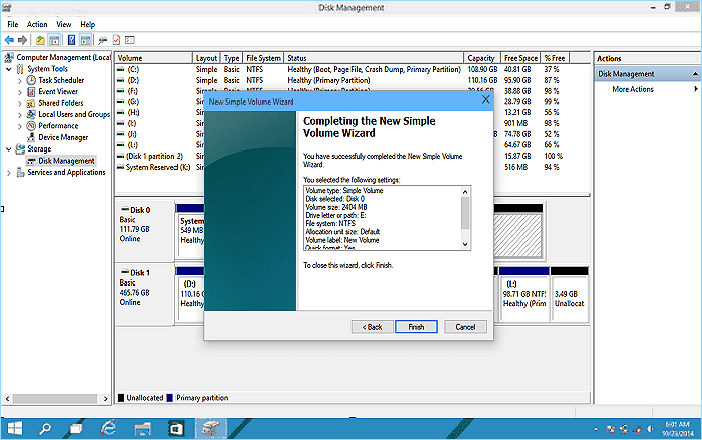
Method 3. Format Unallocated Disk Using CMD
Diskpart is a free utility on Windows. It offers multiple functions for Windows users, such as managing disk partitions and fixing device errors. It can also format the unallocated disk when using CMD. But you need to be careful when typing the command. Let's look at the detailed instructions.
Step 1. Open the run windows and type "cmd."
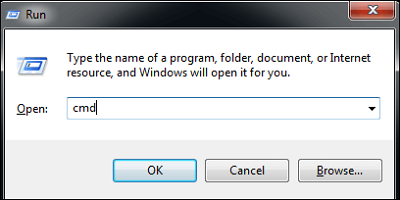
Step 2. Type "diskpart" and press "Enter" to open this program.
Step 3. Type the following commands in order and press "Enter" after each command to execute the program.
list disk – list all the disks in the system
select disk 0 – 0 refers to the number of the unallocated disk you want to format
create partition primary size=20480
assign letter=H – H refers to the number of the partition
format fs=ntfs quick– fat32 refers to the format. You can change it based on your needs
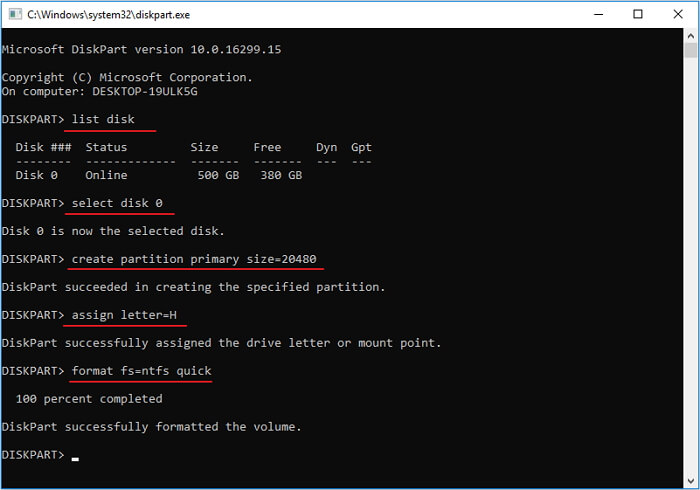
Step 4. Close the window and finish formatting the unallocated disk.
Conclusion
According to this guide, we can learn how to format unallocated disk on Windows. Three methods are offered. Both Disk Management and Diskpart are available to format the unallocated disk. But I highly recommend EaseUS Partition Master for its powerful functions and simple operations. It is a good helper for your computer and can meet the different needs of your disks.
FAQs About How to Format Unallocated Disk
1. How do I format an unallocated drive in Windows 10?
It is easy to format an unallocated drive in Windows 10. EaseUS Partition Master or CMD can format the unallocated drive in this guide. Here is a simple step for using Disk Management to format an unallocated drive in Windows 10:
Step 1. Input "diskmgmt.msc" in the run window and open Disk Management.
Step 2. Right-click the unallocated disk and choose "New Simple Volume."
Step 3. Set the parameter and format of the unallocated drive and click "Finish."
2. Why I can't delete unallocated space?
Because the unallocated space is not part of the partition, you can't use or delete the unallocated space. If you want to use it, you can create a new partition on the unallocated space or extend it to an existing partition.
3. Can you format unallocated space?
Of course, you can format the unallocated space. If you want to format the unallocated space, you need to create a new partition on the disk and then choose the right format for the unallocated space.
Was This Page Helpful?
Daisy is the Senior editor of the writing team for EaseUS. She has been working at EaseUS for over ten years, starting as a technical writer and moving on to being a team leader of the content group. As a professional author for over ten years, she writes a lot to help people overcome their tech troubles.
Cici is the junior editor of the writing team of EaseUS. She accepted the systematic training on computers at EaseUS for over one year. Now, she wrote a lot of professional articles to help people resolve the issues of hard drive corruption, computer boot errors, and disk partition problems.
Related Articles
-
Guide on Best Allocation Unit Size for Gaming [2025 New]
![author icon]() Sherly/2025-07-04
Sherly/2025-07-04 -
Cleaning Up, Do Not Turn Off Your Computer - How to Fix
![author icon]() Larissa/2025-07-04
Larissa/2025-07-04 -
How to Reset PS5 Without Losing Data [2 Tested Methods]
![author icon]() Dany/2025-07-04
Dany/2025-07-04 -
[Too Slow!] How to Fix USB 3.0 Transfer Speed Pretty Slow
![author icon]() Brithny/2025-07-04
Brithny/2025-07-04
EaseUS Data Recovery Services
EaseUS data recovery experts have uneaqualed expertise to repair disks/systems and salvage data from all devices like RAID, HDD, SSD, USB, etc.